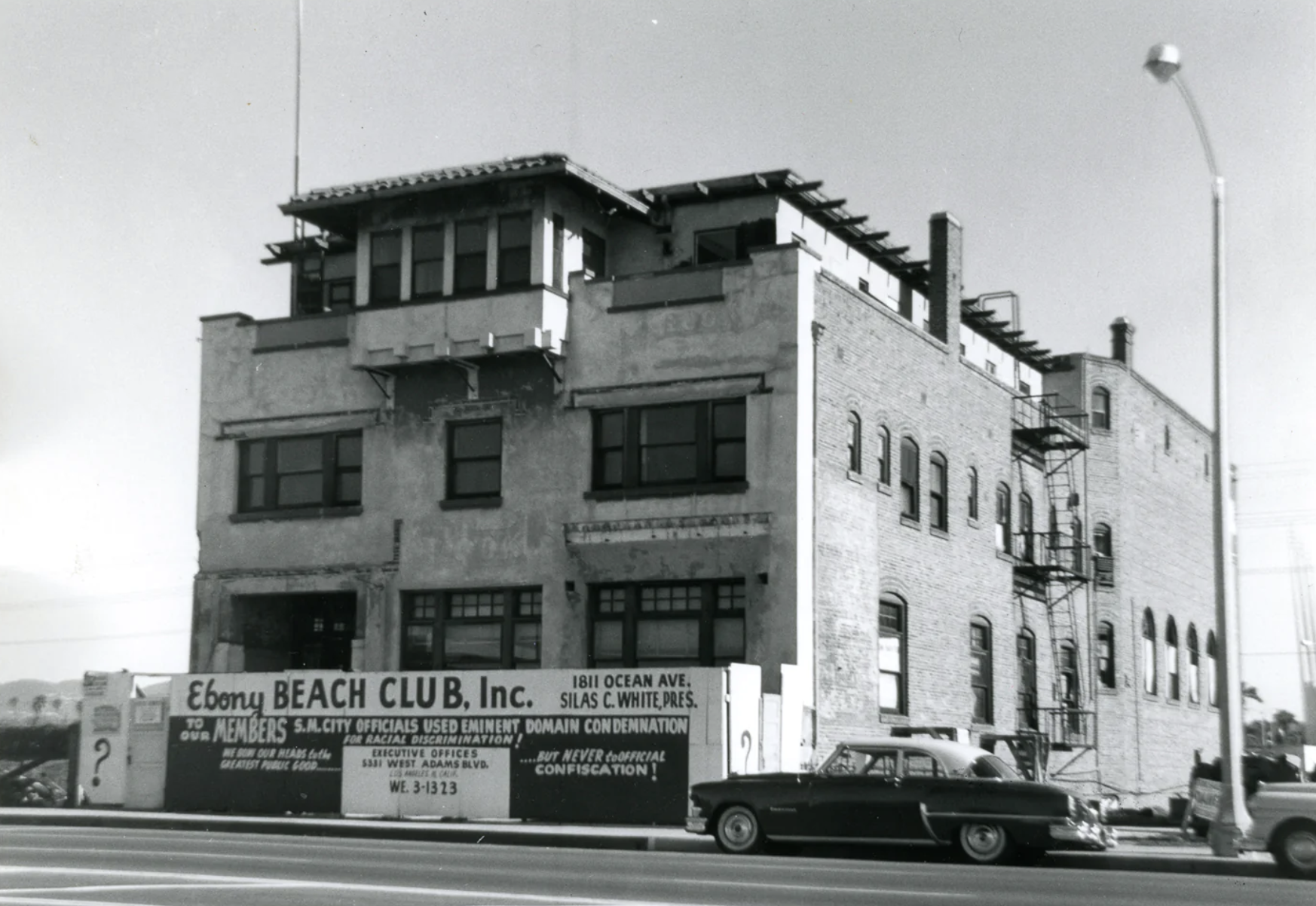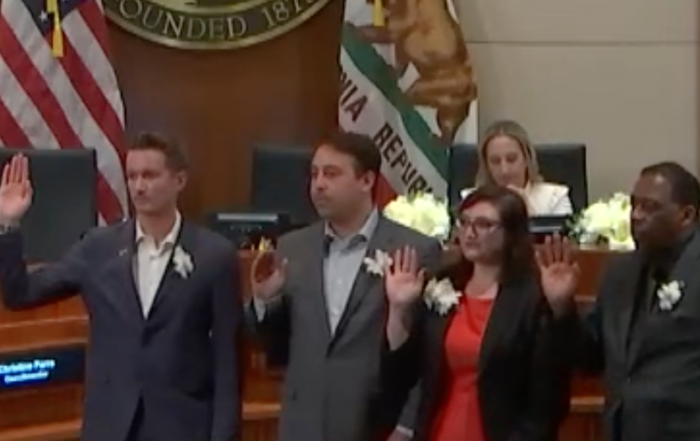I’m only now discovering that there is a shameful, racist past to Santa Monica that existed as recently as 60 years ago.
As far back as 2005, the City of Santa Monica promised a park to replace much of the Civic Auditorium parking lot. A messy planning process resulted in a soccer field being built, which was named “Belmar Park.” But, even after 24 years in Santa Monica including two terms as an elected member of the Rent Control Board and active participation in civic affairs – including a former column in the city’s daily newspaper — I had no idea the significance of the name until my wife suggested we visit a historical exhibit installed on site.
As we arrived one Saturday in May, a soccer game was underway. Parents looked on and shouted words of encouragement to what I remember being a racially diverse set of middle school-age boys. The teams boasted the fancier “soccer kits” worn by advanced-level teams, with matching jerseys, shorts, and socks. We then turned our attention to roughly 20 informational, interpretive historical plaques surrounding the north and east sides of the field. I remember another interested party, a man dressed in work casual with an old-fashioned camera hanging from his neck.
My wife and I slowly paced the area reading the plaques, which were slightly cool to the touch despite being warmed by the sun, with great interest and a level of surprise. They introduced us to people and a Santa Monica we never knew. The site where City Hall, the County Courthouse, the Civic Auditorium, and the Rand Corporation now sit was once a prominent and thriving African American neighborhood called the Belmar Triangle. And it was systematically wiped from the map.
My feelings returned quickly to the awakening I experienced watching HBO’s “Watchmen” in 2019. The limited series’ opening act was a fictionalized depiction of the 1921 Tulsa Massacre, until then unknown to me and millions of Americans. Why hadn’t we been taught about this in schools?! How can I have been ignorant of this?! It brought on feelings of guilt and shame, as did learning about the tragedy of the Belmar Triangle. Just as I dove into researching the Tulsa Massacre following “Watchmen,” I decided to learn more about the Belmar Triangle and try and tell a small part of its story.
The Great Migrations of the early 20th century saw millions of African Americans from the American South move north and west. Many landed in Greater Los Angeles, a natural choice for many looking for work in the hospitality, entertainment, and aerospace industries. From the turn of the 20th Century through the 1950s, Black folks made up the bulk of residents in the Belmar Triangle. They worked, schooled, recreated, and opened businesses and churches. Many migrated to buy property and to build multi-generational wealth. By 1918, the African American community was strong enough in Los Angeles to help elect Fredrick Madison Robert, the first African American Member of the State Assembly.
Dr. Alison Rose Jefferson is an independent historian and heritage conservation consultant and Scholar in Residence at the Institute for the Study of Los Angeles at Occidental College. She has written and spoken extensively on the Belmar Triangle and other Southern California neighborhoods once boasting of rich African American history.
On August 9th, 2021, she spoke with the New Book Network Podcast about why people migrated west, saying, “There was much more freedom for them here in California even though there was still discrimination. One of the things that lessened the discrimination was that California had civil rights laws on the books as early as 1893…Black people could buy property here. Their children could go to school here more easily than in other places.”
She further explained her role as a “heritage conservationist,” saying, “It is an interpretation of place and place-making… and looking at the social stories that make up a place.” The social stories are particularly important, she further explained, where the places no longer have the structures that were torn down. When it comes to Bay Street Beach, adjacent to the Belmar Triangle, she says, “Even the beach has changed,” referring to “beach nourishment campaigns” that widened beaches to encroach on neighborhoods bordering what were once narrower strands of sand. These purposeful “beach improvement projects” were of course also intended to rid neighborhoods like Belmar Triangle of their Black night clubs, food stands, and other spots Black folks relied on for leisure.
In her extended essay, “Reconstruction and Reclamation: The Erased African American Experience in Santa Monica’s History,” Dr. Jefferson describes the Black entrepreneurs that came to South Santa Monica. They had a particular interest in leisure destination businesses, but, she says, “they were challenged by certain racial exclusionary measures that inhibited this economic development.”
During the 1950s, city government forced Belmar residents to leave their homes and close their businesses, using eminent domain and statutes called “condemnation eviction” and “land purchase compensation proceedings.” Jefferson argues that historical preservation (of buildings with historical significance) had not yet thrived as a movement and that many city governments, including Santa Monica’s, saw replacing old buildings and homes with new ones as signs of progress.
It didn’t make things easier for Belmar residents that many of their homes were known as “shotgun houses,” inexpensively built, simple, long wooden buildings that were easily torn down and burned quickly. Several properties were burned, not by angry racist mobs but by organized, racist city actions that declared them “blight.” The civic center buildings that took their place were billed as “infrastructure modernizing,” but were intentional actions built to make cities like Santa Monica less diverse, less affordable, and more exclusive.
Homes weren’t the only structures snuffed out by government action. According to an October 13, 1957 piece by Faline Nurse in High Country News, a Black entrepreneur named Silas White purchased a former Elks Club building on Ocean Avenue to open an African American beach club he wanted to call The Ebony Beach Club. The planned development was near both Belmar Triangle and Bay Street Beach. One investor in Mr. White’s vision was none other than crooner Nat King Cole, who was attracted to White’s vision for renovating the building. Mind you, the Elks Club had been vacated for 13 years. No one was in a hurry to use it. And yet, during the permitting process, the property and adjacent structures were suddenly seized by the City of Santa Monica through eminent domain. The city council determined these spaces were needed for civic center parking. A legal challenge was mounted, but the city won and had the Elks Club demolished in 1960.
Racially charged city councils had their enablers. Around the time Silas White launched his Ebony Beach Club effort, Black investors Charles S. Darden and Norman A. Houston’s Ocean-Front Syndicate resort was targeted by the Santa Monica Bay Protective League – white suburbanites with racial animus that presented themselves merely as a neighborhood protection group – who protested the building permit and successfully derailed the project. Later, Caldwell’s, a popular dance hall frequented by Black Santa Monicans, was shuttered after the League lobbied the city to close nightclubs in residential areas. According to the LAist news site in a 2014 article, the L.A. Times published a statement by the Santa Monica Bay Protective League in June of 1922 that reads:
“In as much as a certain negro syndicate has announced…their intention of making this bay district their beach and bringing thousands of negroes to the beach cities, which we believe would be very detrimental to our property values and our bay district as a whole…We believe that they should procure a beach of their own at a point separate and apart from all the white beaches—which would eliminate all possible friction for all time to come.”
If there is any good news, it is that what happened to Belmar may finally be taught in the classroom. Lesson plans have been developed to meet California education and several cultural and ethnic studies standards. Let’s also hope tomorrow’s students are also taught about the Tulsa Massacre.
I have learned in the process of studying Belmar history and writing this that self-congratulatory intent toward “being a better ally” is worthless. Feeling guilt over one’s privilege is natural. But simply living in it without taking action is a dereliction of duty. As defined by the Southern Poverty Law Center (SPLC), an ally is “someone who stands with or advocates for individuals and groups other than their own.”
Admittedly, publishing a single article to educate others on the injustice done in the Belmar Triangle is insufficient allyship. But if I commit to telling a series of stories of other Los Angeles area neighborhoods that have been erased, could the cumulative effect help confront and re-program our understanding of how today’s Los Angeles was created?
One thing is for sure. I need to be doing a lot more “standing with” and “advocate[ing] for” those in this country who have suffered and still endure institutionalized and constant racism, homophobia, religious bigotry, and misogyny. Only then can I or any of us who have enjoyed privilege meet the SPLC’s definition of “ally.”
May 4, 2022 – This story has an ongoing Epilogue: (Checking in on S.M.’s Housing for Displaced Households Pilot Program)
Stay informed. Sign up for The Westside Voice Newsletter
By clicking submit, you agree to share your email address with Westside Voice. We do not sell or share your information with anyone.








